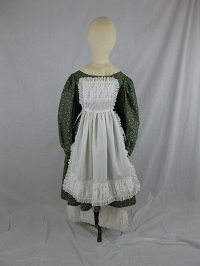1830s
The print of this floral pattern with its harsh contrasts is fairly typical of the 1830s. The low wide necklines popular with the women were extended to the children. Young women and girls wore aprons to protect their clothing. Everyday aprons were typically of dark colors, but for special occasions extra fancy aprons with ruched borders and lace dressed up the outfit. The padded hems of the 1820s have been moved to the undergarments. Several petticoats, some with thick piping, hold out the billowing skirts. The “gigot” sleeves, which were popular from 1824 to 1836, are set into a small high armhole. These large, fully gathered, sleeves are not the maximum width. Also left out are the pillows, or wicker, formerly used to extend them even farther.
As children's clothing took on its own identity and children were no longer dressed as "little adults," new fashions appeared especially for them. Many portraits show children and young ladies with bloomers, pantelettes and ruffles covering the legs between the bottom of the shorter skirts and the top of the shoes. The clergy thought trousers were evil and too masculine for the Victorian women, but children had more freedom and could wear them.
The applied decorations popular in the 1820s became passé and were replaced by brightly patterned materials.
Click photo for detailed views.


